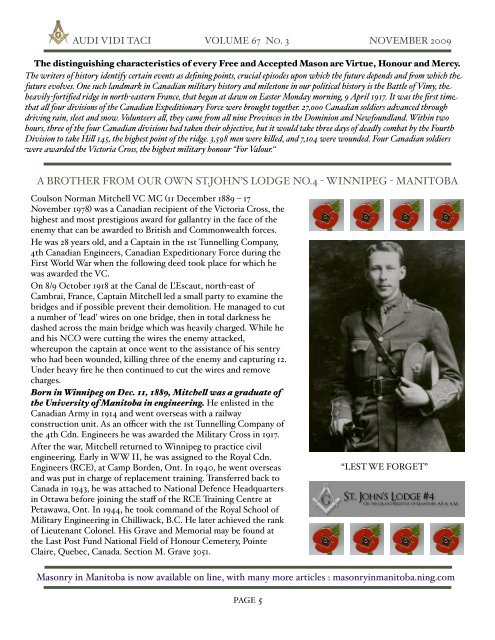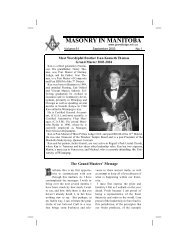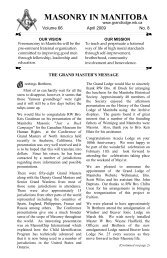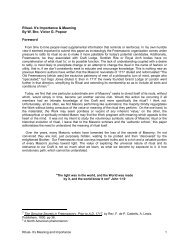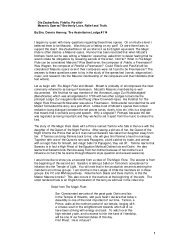You also want an ePaper? Increase the reach of your titles
YUMPU automatically turns print PDFs into web optimized ePapers that Google loves.
AUDI VIDI TACI VOLUME 67 NO. 3 NOVEMBER 2009<br />
The distinguishing characteristics of every Free and Accepted Mason are Virtue, Honour and Mercy.<br />
The writers of history identify certain events as defining points, crucial episodes upon which the future depends and )om which the<br />
future evolves. One such landmark in Canadian military history and milestone in our political history is the Battle of Vimy, the<br />
heavily-fortified ridge in north-eastern France, that began at dawn on Easter Monday morning, 9 April 1917. It was the first time<br />
that a' four divisions of the Canadian Expeditionary Force were brought together. 27,000 Canadian soldiers advanced through<br />
driving rain, sleet and snow. Volunteers a', they came )om a' nine Provinces in the Dominion and Newfoundland. Within two<br />
hours, three of the four Canadian divisions had taken their objective, but it would take three days of deadly combat by the Fourth<br />
Division to take Hi' 145, the highest point of the ridge. 3,598 men were ki'ed, and 7,104 were wounded. Four Canadian soldiers<br />
were awarded the Victoria Cross, the highest military honour “For Valour.“<br />
A BROTHER FROM OUR OWN ST.JOHN’S LODGE NO.4 - W<strong>IN</strong>NIPEG - <strong>MANITOBA</strong><br />
Coulson Norman Mitchell VC MC (11 December 1889 – 17<br />
November 1978) was a Canadian recipient of the Victoria Cross, the<br />
highest and most prestigious award for gallantry in the face of the<br />
enemy that can be awarded to British and Commonwealth forces.<br />
He was 28 years old, and a Captain in the 1st Tunnelling Company,<br />
4th Canadian Engineers, Canadian Expeditionary Force during the<br />
First World War when the following deed took place for which he<br />
was awarded the VC.<br />
On 8/9 October 1918 at the Canal de L'Escaut, north-east of<br />
Cambrai, France, Captain Mitchell led a small party to examine the<br />
bridges and if possible prevent their demolition. He managed to cut<br />
a number of 'lead' wires on one bridge, then in total darkness he<br />
dashed across the main bridge which was heavily charged. While he<br />
and his NCO were cutting the wires the enemy attacked,<br />
whereupon the captain at once went to the assistance of his sentry<br />
who had been wounded, killing three of the enemy and capturing 12.<br />
Under heavy fire he then continued to cut the wires and remove<br />
charges.<br />
Born in Winnipeg on Dec. 11, 1889, Mitchell was a graduate of<br />
the University of Manitoba in engineering. He enlisted in the<br />
Canadian Army in 1914 and went overseas with a railway<br />
construction unit. As an officer with the 1st Tunnelling Company of<br />
the 4th Cdn. Engineers he was awarded the Military Cross in 1917.<br />
After the war, Mitchell returned to Winnipeg to practice civil<br />
engineering. Early in WW II, he was assigned to the Royal Cdn.<br />
Engineers (RCE), at Camp Borden, Ont. In 1940, he went overseas<br />
and was put in charge of replacement training. Transferred back to<br />
Canada in 1943, he was attached to National Defence Headquarters<br />
in Ottawa before joining the staff of the RCE Training Centre at<br />
Petawawa, Ont. In 1944, he took command of the Royal School of<br />
Military Engineering in Chilliwack, B.C. He later achieved the rank<br />
of Lieutenant Colonel. His Grave and Memorial may be found at<br />
the Last Post Fund National Field of Honour Cemetery, Pointe<br />
Claire, Quebec, Canada. Section M. Grave 3051.<br />
“LEST WE FORGET”<br />
Masonry in Manitoba is now available on line, with many more articles : masonryinmanitoba.ning.com<br />
PAGE 5


